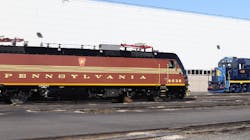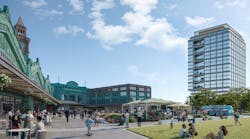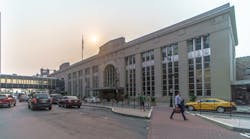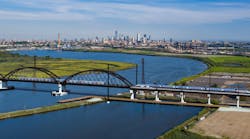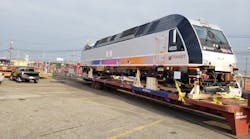NJ Transit celebrates 40-year anniversary of rail operations
New Jersey Transit (NJ Transit) celebrated the agency’s 40th anniversary of assuming control and management of the operations of New Jersey’s commuter rail network Jan. 1.
Shortly after midnight on Jan. 1, 1983, the first NJ Transit trains departed Hoboken and Penn Station New York with crews who were now officially NJ Transit employees. Over the past 40 years, NJ Transit has steadily improved New Jersey’s rail network by investing in modernized equipment, rebuilding the infrastructure and right-of-way, increasing service to Midtown Manhattan, introducing one-seat rides to Penn Station New York on three rail lines, increasing overall capacity, extending electrification on two busy rail corridors and much more.
“Congratulations to the men and women of rail operations for a job well done,” said New Jersey Department of Transportation Commissioner and NJ Transit Board Chair Diane Gutierrez-Scaccetti. “I am proud of NJ Transit’s commitment over the last four decades in providing safe, reliable rail travel for millions of customers all over the state, and we continue to use and invest in the latest technologies and advances to enhance service and safety.”
“Our congratulations and thanks go out to the entire NJ Transit rail operations team, past and present, on the occasion of its 40th anniversary,” said NJ Transit President and CEO Kevin S. Corbett. “With a proud legacy behind us, an extraordinary team now in place, major rail infrastructure projects like the Portal North Bridge Replacement Project currently underway, and 138 new multi-level rail cars beginning to arrive in 2024, the future looks bright for this essential division of NJ Transit – and more importantly, for the millions of customers who depend on it every year.”
In recognition of the anniversary, NJ Transit has painted four locomotives in “Heritage” paint schemes to recognize the predecessor railroads and employees that make up the system. In the photo, ALP46A 4636 wears a Pennsylvania Railroad-inspired scheme while GP40PH-2 4109 appears reminiscent of its as-delivered Central Railroad of New Jersey paint scheme.
History of NJ Transit
On Jan. 1, 1983, a dedicated group of employees — combined with support from the state and federal governments — began transforming an aging and disjointed passenger railroad system into one of the premier passenger railroads of North America. A combination of needed investments, smart planning and a shift in railroad culture from “moving equipment” to “serving customers” led to delivery of a safer and more convenient, reliable and cost-effective service.
Older railcars and locomotives were refurbished or replaced with ADA-accessible equipment. New high-level platforms were built for customers with disabilities and faster boarding and exiting of trains. Signals and overhead-wire catenary systems were modernized. Continuous welded rail was installed for a smoother, faster ride.
As on-time performance and service quality rose, so did ridership, paving the way for more service expansion, including the launch of Atlantic City Rail Line service and the MidTOWN DIRECT service, the opening of the Newark Liberty International Airport Station and the opening of the Frank R. Lautenberg Station at Secaucus Junction that allows customers access to 11 of NJ Transit's 12 rail lines.
NJ Transit also centralized its maintenance and train dispatching functions in Kearny with the opening of the Meadows Maintenance Complex in 1987 and the Rail Operations Center in 2003. These facilities created a more modernized, reliable and efficient method of maintaining and operating trains.
While expanding the capacity of the rail system, NJ Transit concurrently added thousands of new parking spaces, including the addition of major park & ride facilities at Metropark, Ramsey Route 17, Montclair State University, Bay Street, Rahway, Hamilton, Trenton and Morristown stations.
In December 2006, NJ Transit combined its focus on capacity expansion with its ongoing efforts to improve the customer experience by debuting the system’s first multilevel rail car. Multilevel cars (what some may refer to as “Double Deckers”) offer approximately 20 percent more seating capacity than most single-level cars, enabling NJ Transit to accommodate more customers using the existing infrastructure. At every phase, customers participated in the design of the new rail cars, making the multilevel rail cars the first of NJ Transit’s fleet to be designed for customers by customers. A customer design team, composed of 14 NJ Transit commuters from across the system, worked with the manufacturer to provide feedback on interior design, onboard amenities, seat design and color and fabric selection.
In December 2020, NJ Transit had its Positive Train Control (PTC) system certified by the Federal Railroad Administration, which ushered in a new era of safety on the railroad. PTC serves as an enhancement to the railroad’s already comprehensive safety mechanisms to further reduce the possibility of train collisions, excessive speed or unauthorized train movements by utilizing high-tech hardware and software installed throughout the state.
Future of NJ Transit rail
NJ TRANSIT continues to look to the future with new equipment, infrastructure and enhanced customer experience. New bridges, redesigned stations and modern cars and locomotives continue leveraging the latest technology to move the railroad forward.
Infrastructure
In October 2021, NJ Transit added another page to its history book when the board of directors approved the largest single construction contract in the organization’s 40 years with the awarding of a $1.5 billion contract for a new Portal North Bridge.
The new bridge will be a modern two-track, high-level, fixed-span bridge that will improve service and capacity along this section of the northeast Corridor.
The new bridge will rise 50-feet over the Hackensack River and will allow marine traffic to pass underneath without interrupting rail traffic. The project will eliminate the existing 112-year-old swing bridge, which has been the enduring source of major service disruptions for NJ Transit and Amtrak customers traveling on the northeast Corridor.
The Portal North Bridge project is an important initial element of the broader Gateway Program, which will eventually double rail capacity between Newark and New York.
In addition, construction is underway on a new Raritan River Bridge, which carries the North Jersey Coast Line between Perth Amboy and South Amboy. This megaproject will replace a bridge dating back to 1908 with a resilient, modern structure suitable for the next 100 years.
Stations
Modernizing stations is a key aspect of improving the customer experience for the future. NJ Transit is in the process of fully reimagining two of its major rail hubs, Newark Penn Station and Hoboken Terminal. The Murphy Administration has committed $191 million to transform Newark Penn Station and $176 million for improvements around Hoboken Terminal. Construction at Hoboken has also included filling in the unused Long Slip canal to prepare for future rail expansion with six new tracks and high-level platforms, in addition to providing storm resiliency.
Major reconstruction work is underway at Elizabeth, Lyndhurst and Perth Amboy stations with more stations including Roselle Park and Bloomfield in the pipeline. In all, the agency has 20 rail stations in design or active development for future work – the most since the 1800s.
Equipment
In the coming years, NJ Transit will continue to write its history when its first ever self-propelled multilevel rail cars are put into service. Included in an order for 138 new multilevel cars are what’s known as Electric Multiple Units, which do not require a locomotive to push or pull them. They will allow for the retirement of the 40-plus year old single level Arrow fleet and bring with them increased mechanical reliability, additional capacity and new onboard customer amenities such as USB power ports.
The railroad is also actively receiving additional dual power ALP45 locomotives. In all, 25 of these new locomotives will join the fleet and continue to enhance the versatility of the railroad operations with their ability to operate as diesel or electric while also providing improved reliability and reduced emissions.
